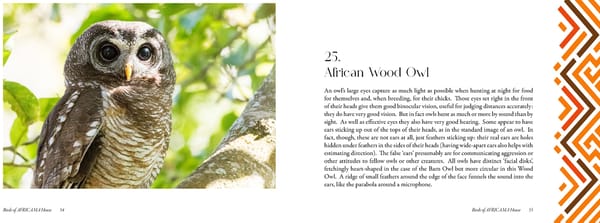25. African Wood Owl An owl’s large eyes capture as much light as possible when hunting at night for food for themselves and, when breeding, for their chicks. Those eyes set right in the front of their heads give them good binocular vision, useful for judging distances accurately: they do have very good vision. But in fact owls hunt as much or more by sound than by sight. As well as effective eyes they also have very good hearing. Some appear to have ears sticking up out of the tops of their heads, as in the standard image of an owl. In fact, though, these are not ears at all, just feathers sticking up: their real ears are holes hidden under feathers in the sides of their heads (having wide-apart ears also helps with estimating direction). The false ‘ears’ presumably are for communicating aggression or other attitudes to fellow owls or other creatures. All owls have distinct ‘facial disks’, fetchingly heart-shaped in the case of the Barn Owl but more circular in this Wood Owl. A ridge of small feathers around the edge of the face funnels the sound into the ears, like the parabola around a microphone. Birds of AFRICAMA House 54 Birds of AFRICAMA House 55
 Birds of Africama 1 Page 27 Page 29
Birds of Africama 1 Page 27 Page 29